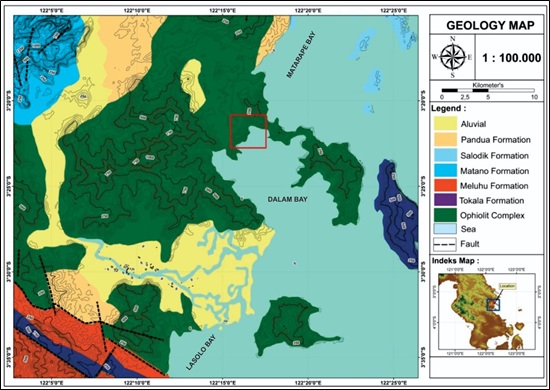Serpentinization Study On Ultramafic Rock at Morombo Area, Lasolo Islands District, North Konawe Regency, Southeast Sulawesi, Indonesia
DOI:
https://doi.org/10.25299/jgeet.2022.7.1.6643Keywords:
Serpentine, Serpentinization, Ultramafic, MoromboAbstract
The research is in Morombo area, North Konawe Regency, Southeast Sulawesi. The purpose of this study was to determine the characteristics of serpentinized ultramafic rock and serpentine paragenesis. Research was conducted using field observations and laboratory analysis consisting of petrographic and geochemical analysis in the form of X-Ray Fluorosence (XRF). Petrographic analysis was carried out to identify the mineral content and textures in the rock and to determine the percentage of serpentine mineral presence. Both of these rocks are petrographically dominated by primary minerals olivine and clinopyroxine and secondary minerals namely lizardite, chrysotile, antiorite and opaque minerals. The XRF analysis was to determine the elements of Ni, Fe, Co, MgO, SiO2, CaO, Al2O3 and P in ultramafic rocks. The results of petrographic analysis show that serpentinized ultramafic rocks in the study area consist of serpentinized dunite and serpentinized peridotite. The formation of clay minerals in rocks does not occur because of the low serpentinization process in the rock. The results of XRF analysis showed that all samples in the bedrock showed Ni content above 0.2%. This is caused by the enrichment of Ni which is interpreted as a result of the serpentinization process along with the formation of lizardite in the rock. The serpentinization sub-processes in the study area comprised by hydration, serpentine recrystallization, and deserpentinization. Serpentine paragenesis is formed from the mid-oceanic ridge ocean floor, the orogenic phase to weathering. Substitution of Mg by Ni in ultramafic rocks will produce Ni-Serpentin. It is estimated that in the research area lizardite and chrysotile lizardite and chrysotile are the causes of Ni enrichment in bedrocks. The serpentinization characteristics of ultramafic rocks in the study area show a low to moderate level of serpentinization.
Downloads
References
Brand, N. W., Butt, C. R. M., & Elias, M. 1998. Nickel laterites: classification and features. AGSO Journal of Australian Geology & Geophysics, 17(4), 81–88.
David, S., & O’Hanley. 1991. Fault-Related Phenomena Associated and Serpentine With Hydration Recrystallization During Serpentinization Souvernp. Canadian Mineralogist, 29, 21–35.
Freyssinet, PH., Butt, C.R.M, M. R. . 2005. Ore-Forming Processes Related to Lateritic Weathering. Economic Geology 100th Anniversary Volume, 681–722.
Guillot, S., Schwartz, S., Reynard, B., Agard, P., & Prigent, C. 2015. Tectonic significance of serpentinites. Tectonophysics, 646,hal 1–19.
Hasria., Anshari, E., Muliddin., Restele, L. O., & Zulkifli, L. O. M., 2019a.The Effect of Geological Structure on the Distribution of Nickel (Ni) and Iron (Fe) Contents in Laterite Nickel Deposits in the Saprolite Zone of PT. Manunggal Sarana Surya Pratama, District Lasolo Islands, North Konawe Regency, Southeast Sulawesi. Technology Research Journal Mining, 6(1), 38–45.
Hasria., Anshari, E., & Rezky, T. B., 2019b. Effect of Bedrock and Geomorphology on Laterization and Distribution of Ni and Fe content in the laterite nickel deposit at PT. Tambang Bumi Sulawesi, Village Pongkalaero,
Bombana Regency, Southeast Sulawesi. Journal of Application Geography and Technology, 3(1), 47–58.
Hasria., Asfar, S., Ngkoimani, L.O., Okto, A., Jaya, R.I.M.C., Sepdiansar, R. 2021. The influence of Geomorphology on the Distribution of Nickel and Iron Elements in Laterite Nickel Deposits in Buton Regency, Central-Southeast Sulawesi. Geosapta Journal 7(2), 103-114.
Hasria., Hasan, S.H., Deniyatno., Salihin, L.M.I., Asdiwan, 2020. Characteristics of Ultramafic Igneous Rock Ophiolite Complex in Asera District, North Konawe Regency Southeast Sulawesi Province. Journal of Geoscience, Engineering, Environment and Technology 5(3), 114-118.
Jacques, B. 2002. Field Determination of Serpentinisation at Soroako. Lectures Notes PT. INCO, Sorowako.
Kurniadi, A., Rosana, M. F., Yuningsih, E. T., Pambudi, L. 2017. Karakteristik Batuan Asal Pembentukan Endapan Nikel Laterit di Daerah Madang dan Serakaman Tengah. Geoscience Journal, 1(2), 149–163.
Mevel, C. 2003. Serpentinization Of Abyssal Peridotites at Mid Ocean Ridges. Comptes Rendus - Geoscience, 335, 825–852.
Moody, J. B. 1976. Serpentinization: a review. Lithos, 9(2), 125–138.
O’Hanley, D. S. 1992. Solution to the volume problem in serpentinization. Geology, 20(8), 705–708.
Oud, K. 2010. Serpentinization and Fracture Formation in Peridotites on Otrøy, Western Gneiss Region, Norway: Late stage PT-conditions and implications for tectonic decompression. Thesis.
Sufriadin. 2013. Mineralogy Geochemistry and Leaching Behavior of The Soroako Nickeliferous Laterite Deposits, Sulawesi,Indonesia. Disertasion.
Sufriadin, Idrus, A., Pramumijoyo S,. Warmada, I. W., Nur, I., S. 2009. Serpentinisasi Pada Batuan Ultramafik dan Implikasinya Terhadap Eksplorasi Endapan Nikel Laterit. Proceedings of International Conference Earth Science and Technology. Yogyakarta. hal. 161-168

Downloads
Published
Issue
Section
License
Copyright @2019. This is an open-access article distributed under the terms of the Creative Commons Attribution-ShareAlike 4.0 International License which permits unrestricted use, distribution, and reproduction in any medium. Copyrights of all materials published in JGEET are freely available without charge to users or / institution. Users are allowed to read, download, copy, distribute, search, or link to full-text articles in this journal without asking by giving appropriate credit, provide a link to the license, and indicate if changes were made. All of the remix, transform, or build upon the material must distribute the contributions under the same license as the original.










